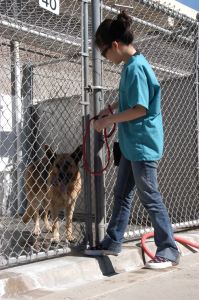Shelters are not “kill” and “no-kill.” They are “open admission” and “limited admission.”
Woman taking GSD out of shelter kennel

Photo courtesy of Cattle Dog Publishing
The words we use matter. For instance, during the pandemic, we (mostly) accept the rules our governmental agencies give us if we feel we're all in the same boat. However, if following the rules make you feel like you're in a dingy while your neighbor is in a yacht, then odds are you won't follow them. While a dingy and a yacht are both boats, as individual words, they conjure different pictures in your head. One represents desperation and poverty while the other is a picture of wealth and abundance.
This is why I was riled recently by a local story in the newspaper that mentioned a “no-kill” animal shelter. I hate that term. It's divisive and unnecessary. Shelters are not “kill” and “no-kill." They are “open admission” and “limited admission." Even so-called no-kill shelters perform euthanasias or transfer animals to other locations for euthanasia. And in most communities, “kill” and “no-kill” shelters work together. When it's going well, they both may be part of what is a growing movement, socially conscious sheltering.
The no-kill movement began with a laudable goal: to stop euthanizing shelter pets simply to make room for more shelter pets. In other words, stop euthanizing healthy, adoptable animals. It's a commendable goal. But some folks simplified it to stop euthanizing any pets. Period. That isn't realistic and can lead to suffering and hoarding.
Many municipal shelters are open admission. This means they take in all unwanted animals including the sick, the old, and the dangerous. In many cases, it also means they legally cannot turn away any animal. And because they depend mostly on taxpayer money, oftentimes they are underfunded. If they can't turn off the spigot of incoming, unwanted animals, then they need to bail faster to keep the boat from sinking (their boat is often a dingy, not a yacht). That means they need animals to leave the shelter at least as quickly as they are coming in. This can be accomplished by adopting animals to the public, transferring animals to other shelters and rescue organizations, and unfortunately, by euthanizing. With any luck, the animals that are euthanized are ones that couldn't have been adopted anyway due to underlying health or behavior conditions. If their luck runs out, they may have to euthanize animals that could have been treated or that are healthy.
On the other hand, many private shelters are limited admission. They get animals from municipal shelters, private owners, and other locations, but only those they want, limiting the number of animals they admit. This means that they can just say “no” to more animals. If they are at capacity, then they just turn off the spigot until their numbers decrease. This can allow them to invest more time, labor, and resources into each pet. When their numbers get low, they carefully reopen the spigot allowing new animals in.
Open-admission and limited-admission shelters often work together to serve their communities. Imagine that the former is like a triage station, bringing in animals quickly, assessing their needs, and as soon as any stray-hold requirements are met, just as quickly moving them to the right track. For any given animal, that track may be to go straight up front to adoption; to the back for spay/neuter, vaccines, and basic care prior to adoption; to transfer out to a partner shelter for adoption or more intensive care elsewhere; or to be euthanized if that is the best plan to stop pain and suffering of all sorts. That third track – transfer to a partner shelter – is where limited admission shelters come in. They are an important and integral part of the system. Often they are what allows for heartworm treatment, ringworm treatment, fracture repair, and other, more involved care to take place. It's like moving from the emergency room to the critical care ward or the rehabilitation wing: they do what there isn't time and resources to do in the ER.
In order to honor this relationship between open-admission and limited-admission shelters, there is a new movement towards socially conscious sheltering. It eliminates the false dichotomy of kill/no-kill. It suggests that we're all in this together. Consideration is given not only to the needs of the animals, but also to the needs of the community. What might work in a large urban city may not work in a small rural town. But so long as the community is working towards care for all the animals that live there, then hopefully no euthanasias will occur due to a lack of space.
Because words matter, please discontinue the use of no-kill when describing an animal shelter. Animal shelters of all varieties take care of animals. Period.
1 Comment
Barbara J Casey
May 17, 2021